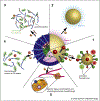Activatable nanoprobes for biomolecular detection
- PMID: 25687686
- PMCID: PMC8848300
- DOI: 10.1016/j.copbio.2015.01.009
Activatable nanoprobes for biomolecular detection
Abstract
Precise detection of pathologically relevant biomolecules could provide essential information on important intercellular, cellular, and subcellular events for accurate disease diagnosis and staging, thus leading to appropriate treatment recommendation. Activatable nanoprobes are nanoscale objects that can be turned on through specific reactions or interactions with biomolecules of interest, and afford some advantageous properties for improved detection of biomolecules both in vitro and in vivo. In this brief review, we highlight several recent examples in the development of activatable nanoprobes for biomolecule detection.
Copyright © 2015 Elsevier Ltd. All rights reserved.
Figures




Similar articles
-
Stereospecific interactions between chiral inorganic nanomaterials and biological systems.Chem Soc Rev. 2020 Apr 21;49(8):2481-2503. doi: 10.1039/d0cs00093k. Epub 2020 Mar 16. Chem Soc Rev. 2020. PMID: 32176233 Review.
-
Bioresponsive peptide-inorganic hybrid nanomaterials.Chem Soc Rev. 2010 Sep;39(9):3358-70. doi: 10.1039/b919461b. Epub 2010 Jul 2. Chem Soc Rev. 2010. PMID: 20596582 Review.
-
Versatile Types of Organic/Inorganic Nanohybrids: From Strategic Design to Biomedical Applications.Chem Rev. 2019 Feb 13;119(3):1666-1762. doi: 10.1021/acs.chemrev.8b00401. Epub 2018 Dec 28. Chem Rev. 2019. PMID: 30592420 Review.
-
Inorganic nanomaterials for tumor angiogenesis imaging.Eur J Nucl Med Mol Imaging. 2010 Aug;37 Suppl 1:S147-63. doi: 10.1007/s00259-010-1452-y. Eur J Nucl Med Mol Imaging. 2010. PMID: 20461373 Review.
-
Small organic molecule templating synthesis of organic-inorganic hybrid materials: their nanostructures and properties.Nanoscale. 2010 Mar;2(3):323-34. doi: 10.1039/b9nr00192a. Epub 2009 Dec 1. Nanoscale. 2010. PMID: 20644814 Review.
Cited by
-
Protease-Sensitive Nanomaterials for Cancer Therapeutics and Imaging.Ind Eng Chem Res. 2017 May 24;56(20):5761-5777. doi: 10.1021/acs.iecr.7b00990. Epub 2017 Apr 24. Ind Eng Chem Res. 2017. PMID: 28572701 Free PMC article. Review.
-
Recent advances in high-performance fluorescent and bioluminescent RNA imaging probes.Chem Soc Rev. 2017 May 22;46(10):2824-2843. doi: 10.1039/c6cs00675b. Chem Soc Rev. 2017. PMID: 28345687 Free PMC article. Review.
-
Fluorescent Block Copolymer Micelles That Can Self-Report on Their Assembly and Small Molecule Encapsulation.Macromolecules. 2016 Jan 26;49(2):653-662. doi: 10.1021/acs.macromol.5b02152. Epub 2016 Jan 6. Macromolecules. 2016. PMID: 27065494 Free PMC article.
-
Building Nanostructures with Drugs.Nano Today. 2016 Feb;11(1):13-30. doi: 10.1016/j.nantod.2015.11.003. Nano Today. 2016. PMID: 27066106 Free PMC article.
-
Design and assembly of supramolecular dual-modality nanoprobes.Nanoscale. 2015 Jun 7;7(21):9462-6. doi: 10.1039/c5nr01518a. Nanoscale. 2015. PMID: 25967580 Free PMC article.
References
-
- Weinberg RA: The Biology of Cancer. Garland Science; 2007.
-
- Clayton TA, Lindon JC, Cloarec O, Antti H, Charuel C, Hanton G, Provost JP, Le Net JL, Baker D, Walley RJ et al.: Pharmaco-metabonomic phenotyping and personalized drug treatment. Nature 2006, 440:1073–1077. - PubMed
-
- Aebersold R, Mann M: Mass spectrometry-based proteomics. Nature 2003, 422:198–207. - PubMed
Publication types
MeSH terms
Substances
Grants and funding
LinkOut - more resources
Full Text Sources

